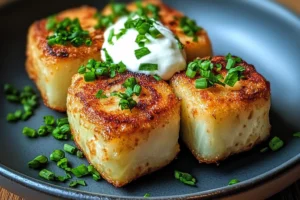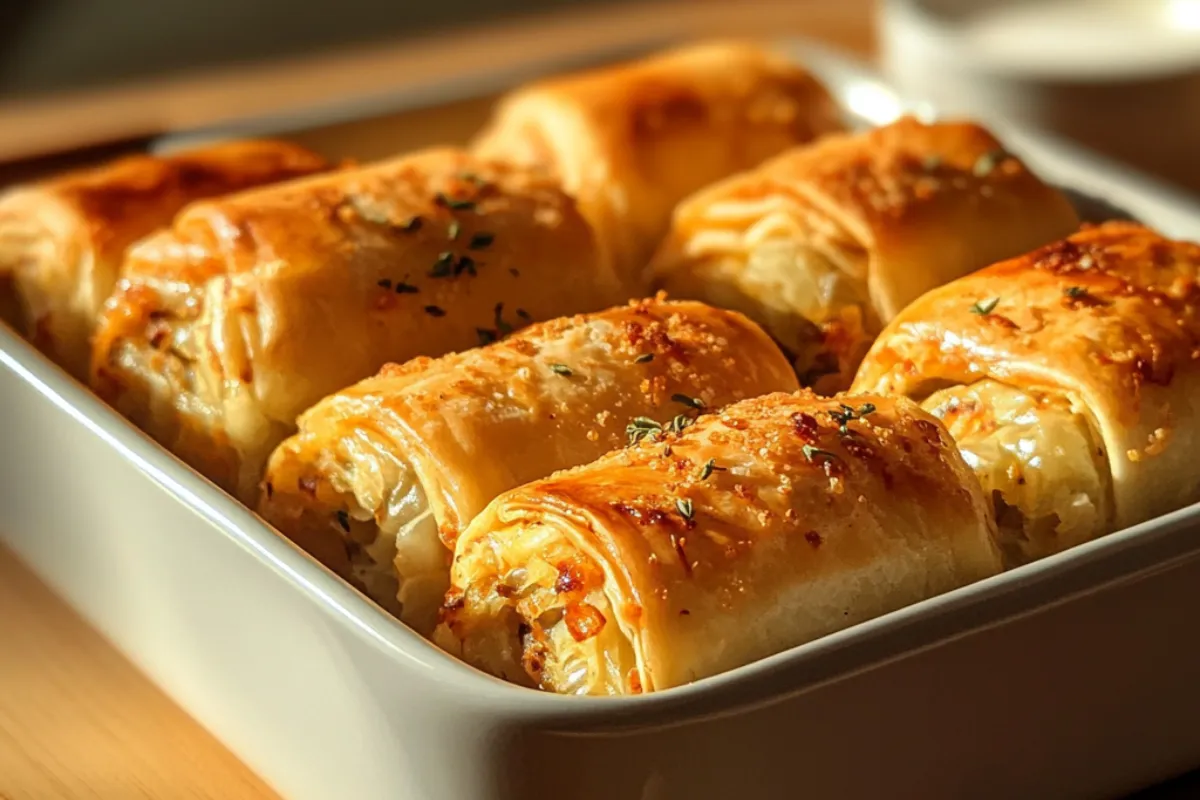Polish stuffed cabbage rolls, known as Gołąbki, are a timeless dish with deep historical and cultural significance in Polish cuisine. This hearty and comforting meal is widely enjoyed across Poland and the world. Whether you are preparing it for a festive celebration, a family gathering, or simply for a home-cooked meal, Gołąbki never fail to deliver rich flavors and a sense of Polish tradition.
This article will guide you through the historical origins, ingredients, preparation techniques, and the cultural importance of Gołąbki. By the end, you’ll also discover some modern twists on the traditional recipe, and how to serve this iconic Polish dish for your next meal. Let’s begin our culinary journey with the story behind this beloved dish.
Explore Polish Culture and Gołąbki’s Origins – Dive into Polish culinary traditions and learn more about the history of Gołąbki.
The Origins and History of Gołąbki
The name Gołąbki literally translates to “little pigeons” in Polish, a reference to the shape of the cabbage rolls, which some believe resemble small birds. The dish itself has a long history and is believed to have originated in ancient Armenia and Persia, where stuffed vegetables were common. These recipes gradually spread across Eastern Europe and were embraced by various cultures, including the Polish, who adapted the dish as their own.
Historically, stuffed cabbage rolls have been a common dish in many European countries, but the Polish version is particularly significant. The Gołąbki has deep ties to Polish cuisine and culture, where it is often prepared for holidays, family gatherings, and special occasions. The evolution of this dish reflects a blend of influences from neighboring cultures, including Jewish culinary traditions.
Gołąbki is not only a meal but also a reflection of Polish hospitality. It is often associated with Polish family gatherings, where the dish is passed down through generations, enjoyed by all in large quantities, and prepared with love. The influence of Polish immigrants in the United States and other parts of the world has also helped spread this dish beyond Poland’s borders.
Learn more about the origins and cultural significance of Gołąbki through this informative article about Polish culinary history. Explore Polish Culinary Traditions.
Evolution Through Time

The evolution of Gołąbki is closely tied to the changes in the Polish economy and the availability of ingredients. In the early days, this dish was often made with whatever ingredients were available in local markets. This flexibility allowed Gołąbki to remain a staple in Polish households despite the varying availability of meats, grains, and other ingredients.
As Gołąbki spread throughout Eastern Europe, various adaptations emerged in different regions of Poland. The dish, while retaining its core concept, took on new characteristics based on local preferences and available ingredients.
In Poland, Gołąbki were traditionally filled with a combination of beef, pork, or even veal, combined with rice, and then wrapped in cabbage leaves. These rolls were often simmered in a rich, tomato-based sauce or a flavorful broth. The dish was made more affordable for families by using cheaper cuts of meat and adding grains like rice or buckwheat, providing a satisfying meal that could feed large families.
The combination of ingredients and preparation techniques became a signature of Polish comfort food, and over time, Gołąbki became synonymous with Polish hospitality and family.
Ingredients: The Heart of Gołąbki
The beauty of Gołąbki lies in its simplicity and flexibility. Traditional Gołąbki ingredients include cabbage, meat, rice, and a variety of herbs and spices, each playing a role in making the dish flavorful and satisfying. Let’s break down the essential ingredients that make this dish so delicious:
- Cabbage: The base of Gołąbki, typically white cabbage, though savoy cabbage is sometimes used for a slightly different texture. The cabbage leaves are softened by blanching, which makes them easier to roll and stuff.
- Meat: Beef and pork are the most commonly used meats, although you can also find versions made with veal or even turkey for a lighter variation. The combination of these meats creates a rich and savory filling that is the heart of the dish.
- Rice: Typically white rice is used in Gołąbki, but alternatives such as barley or buckwheat may be used in certain regional versions. The rice acts as a binder for the filling and absorbs the flavors of the meat and seasonings.
- Herbs and Spices: Commonly used herbs include marjoram, dill, thyme, and bay leaves. These spices are what give Gołąbki its distinct aroma and flavor profile.
- Sauce: The sauce can be made with a variety of ingredients, but a tomato-based sauce is the most common. Some regional variations use mushroom sauce or a sweet-and-sour sauce, adding richness and tang.
By combining these ingredients, Gołąbki delivers a balanced dish that is flavorful, filling, and satisfying. The cabbage adds a mild bitterness, the meat offers richness, the rice binds the filling, and the sauce brings everything together into a savory and delicious meal.
For more in-depth guidance on making Gołąbki and other Polish dishes, this article provides additional insight into the most authentic Polish recipes. Discover More Polish Recipes.
Preparation of Gołąbki: Step-by-Step Guide

Making Gołąbki might seem intimidating at first, but with a little practice, you can easily master the art of preparing this dish. Here’s a detailed, step-by-step guide to making traditional Polish stuffed cabbage rolls:
- Prepare the Cabbage Leaves:
- Begin by removing the tough core from a head of cabbage. To make the leaves pliable for rolling, blanch the entire cabbage in boiling water for 3-4 minutes. Once the leaves are softened, carefully peel them off and set them aside.
- Cook the Rice:
- While the cabbage is cooling, cook the rice according to package instructions. It’s important to undercook the rice slightly, as it will continue to cook inside the cabbage rolls. You can also use barley or buckwheat, depending on the regional variation you prefer.
- Prepare the Meat Filling:
- In a large skillet, sauté finely chopped onions until translucent. Add the ground beef and pork (or your choice of meat) and cook until browned. Once the meat is fully cooked, mix it with the cooked rice and season the filling with herbs like marjoram, dill, and bay leaves. Season with salt and pepper to taste.
- Assemble the Rolls:
- Lay each cabbage leaf flat and place a spoonful of the meat mixture in the center. Carefully roll up the cabbage leaf around the filling, tucking in the sides to form a neat, compact roll. Use toothpicks or kitchen twine to secure the rolls if needed.
- Cook the Gołąbki:
- Arrange the cabbage rolls tightly in a large pot, layering them if necessary. Pour a tomato sauce or your preferred sauce over the top, making sure the rolls are covered. Simmer for 1-1.5 hours, allowing the flavors to meld together.
This traditional preparation method ensures that the rolls cook evenly and that the cabbage remains tender without falling apart. The filling is infused with the aromatic spices, making each bite savory and delicious.
Print
Polish Stuffed Cabbage Rolls
- Total Time: 2 hours
- Yield: 6 servings 1x
Description
Polish stuffed cabbage rolls, known as Gołąbki, are a timeless dish with deep historical and cultural significance in Polish cuisine. These hearty rolls are filled with a savory mixture of meat and rice, wrapped in tender cabbage leaves, and simmered in a flavorful sauce.
Ingredients
- 1 large head of cabbage
- 1 lb ground beef
- 1/2 lb ground pork
- 1 cup cooked white rice
- 1 medium onion, finely chopped
- 2 garlic cloves, minced
- 1 tsp marjoram
- Salt and pepper to taste
- 1 can (28 oz) crushed tomatoes
- 1 cup beef broth
- 1 tbsp tomato paste
- 2 tbsp butter
- 1 tbsp olive oil
- Fresh dill for garnish (optional)
Instructions
- Remove the core from the cabbage and blanch the whole head in boiling water for 3-4 minutes. Peel off softened leaves and set aside.
- Cook the rice according to package instructions and let it cool.
- In a pan, sauté onions and garlic in butter until translucent.
- In a bowl, mix ground beef, pork, cooked rice, sautéed onions, marjoram, salt, and pepper.
- Place a portion of the meat mixture onto each cabbage leaf, fold in the sides, and roll tightly.
- Heat olive oil in a large pot and brown the cabbage rolls slightly.
- Mix crushed tomatoes, tomato paste, and beef broth, then pour over the rolls.
- Cover and simmer for 1-1.5 hours until cabbage is tender.
- Garnish with fresh dill and serve warm.
Notes
For a lighter version, use turkey instead of beef and pork. You can also experiment with different sauces, such as mushroom or a sweet-and-sour variation.
- Prep Time: 30 minutes
- Cook Time: 90 minutes
- Category: Main Course
- Method: Stovetop
- Cuisine: Polish
Nutrition
- Serving Size: 1 roll
- Calories: 420
- Sugar: 6g
- Sodium: 800mg
- Fat: 22g
- Saturated Fat: 8g
- Unsaturated Fat: 12g
- Trans Fat: 0g
- Carbohydrates: 32g
- Fiber: 4g
- Protein: 28g
- Cholesterol: 85mg
Keywords: Gołąbki, stuffed cabbage, Polish cuisine, comfort food

